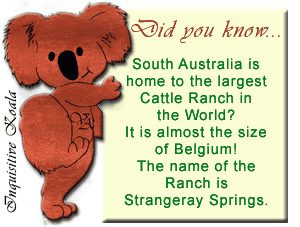





 |
AUSTRALIA
~
Exploration ~
 For
years, the rugged Blue Mountains blocked western expansion of the
Sydney settlement. In 1813 the discovery of a passage over the
mountains by Gregory Blaxland, William
Wentworth and William Lawson opened the way for inland
exploration. Allan Cunningham, a botanist, discovered the rich
Darling Downs of southern Queensland, and John
Oxley, surveyor, found the Brisbane River. For
years, the rugged Blue Mountains blocked western expansion of the
Sydney settlement. In 1813 the discovery of a passage over the
mountains by Gregory Blaxland, William
Wentworth and William Lawson opened the way for inland
exploration. Allan Cunningham, a botanist, discovered the rich
Darling Downs of southern Queensland, and John
Oxley, surveyor, found the Brisbane River.
Settlements were established on the
Brisbane River, Queensland, in 1824; on the Swan River, Western
Australia, in 1829; on Port Phillip Bay, Victoria, in 1835; and on
Gulf St Vincent, South Australia, in 1836. Today, the capital
cities of five states are on those sites.
Western Australia and South
Australia were granted legislative councils in 1838 and 1842
respectively. The British Government's Australian Colonies
Government Act 1850 empowered the colonies to establish
legislatures, determine the franchise and frame constitutions.
Public agitation forced an end to convict transportation to the
mainland in 1840 and to Tasmania 13 years later. Western
Australia, a free settler's colony short of labour, elected to
receive quotas of convicts between 1850 and 1868.
In April 1851,
Edward
Hargraves (1816-91) found gold at Summer Hill Creek near
Bathurst in New South Wales. With the recent experience of the
California gold rush in mind, others joined in the rush, which
quickly became centred in Victoria at Mount Alexander, Ballarat,
and Bendigo. Gold was later found elsewhere in New South Wales and
Queensland. In the following ten years, Australia exported more
than $24 million worth of gold. By that time (1861), the
Australian population had reached almost 1.2 million, a threefold
increase over the 1850 population of 400,000.
In Victoria, miners quickly became
irritated with the high cost of mining licenses and restrictions
on their right to search for gold. Before the fees were reduced, a
small band of miners staged an uprising at the Eureka stockade at
Ballarat in December 1854. As the richest alluvial fields became
worked out and companies mined the reefs, many miners took up
farming.

In the 1860s the goldfields began
to decline. Although wool exports kept the colonies fairly
prosperous, colonial debate soon centred on the role of government
in the economy. In particular, railroad construction, due to costs
and the absence of internal market centres, became a government
activity. In 1866 Victoria, followed by South Australia and
Tasmania, adopted a policy of high tariffs on imported goods in
order to protect its own small industries and markets. New South
Wales (and Queensland to a lesser extent) continued to stay with a
free-trade policy. Throughout the 1870s and '80s, the arguments
over free trade versus protection divided the press, the political
parties, and the colonies. This, together with the continuing
jealousies among them, hindered any significant attempts at
cooperation and possible union among the six colonies until the
1890s.
 The
countervailing need to protect or promote common interests led to
a series of inter-colonial conferences of premiers at irregular
intervals from 1863. The idea of unification appeared as early as
1847 in proposals by Earl Grey (1802-94), Britain's colonial
secretary. In the 1850s John
Dunmore Lang (1799-1878), a Scottish Presbyterian cleric in
New South Wales, formed the Australian League to campaign for a
united Australia. A draft federal constitution was drawn up in
1891 at a convention sponsored by the Premier of New South Wales,
Sir
Henry Parkes. A further convention in 1897-98 refined it into
the Australian Constitution. The
countervailing need to protect or promote common interests led to
a series of inter-colonial conferences of premiers at irregular
intervals from 1863. The idea of unification appeared as early as
1847 in proposals by Earl Grey (1802-94), Britain's colonial
secretary. In the 1850s John
Dunmore Lang (1799-1878), a Scottish Presbyterian cleric in
New South Wales, formed the Australian League to campaign for a
united Australia. A draft federal constitution was drawn up in
1891 at a convention sponsored by the Premier of New South Wales,
Sir
Henry Parkes. A further convention in 1897-98 refined it into
the Australian Constitution.
Population growth and economic
expansion prompted the colonies to call for self-government. On 1
January 1901 the six colonies joined in a federation of states to
become the Commonwealth of Australia.
Copyright
unknown

History
Index

|






 |